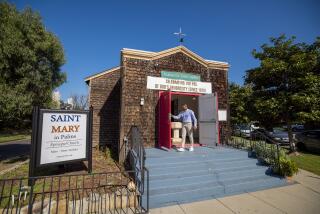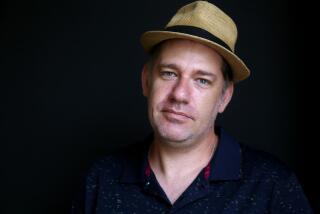Need Still Great for SRO Space
- Share via
San Diego’s new single-room occupancy residential hotels are garnering alot of attention, not just here but across the country. Out-of-town architects, planners, developers and politicians often inquire about the roughly 1,000 new SRO rooms built here since The Baltic Inn became the first new SRO in more than 50 years when it opened in 1986.
Building code changes helped pave the way for the new projects, easing sewer hookup fees, parking requirements and various code restrictions to compensate for the expensive fire sprinklers required because low-cost construction is more combustible.
But while the bright new SROs, many of them built with financial assistance from the San Diego Housing Commission, are getting the spotlight, the housing situation for low-income people still looks bleak, particularly downtown, where the new SROs are concentrated.
By some estimates, there were nearly 10,000 SRO rooms in downtown San Diego before redevelopment began in the 1970s. Now there are about 3,500, and, despite more than 1,000 additional SRO rooms due in the next year or two, the total number will fall 1,000 rooms short of meeting the annual demand for new rooms between now and 1991, according to a Housing Commission survey.
There are actually two problems: New SROs can’t be built fast enough, and older units are facing extinction.
Cleared of Tenants
The Gordon Hotel, a 26-room SRO at 1334 7th Ave., where rents start at less than $200, has been cleared of tenants by its owners, 600 Associates, even though they haven’t gotten demolition or building permits.
The Housing Commission has yet to determine whether the Gordon is exempt from the city’s SRO Preservation Ordinance (which requires developers to replace, or pay for the replacement of, any SRO rooms demolished), or whether it has adequately provided for the relocation of tenants.
Right now, the developers won’t divulge their plans for the Gordon. Kathy Rodman, an attorney for the Legal Aid Society, which represents low-income clients, is working with an undisclosed group of San Diegans in the hope of preventing demolition. She said a contractor hired by her clients found the building to be structurally sound and a good candidate for rehabilitation.
For many people, older SROs such as the Gordon are the last rung of housing before the streets, with rates substantially below the $310 average rate for new SROs.
Thousands of families need low-cost housing, according to the San Diego Housing Trust Fund Coalition, a group of low-income housing advocates for the fund being proposed by the Housing Commission. The coalition estimates that 4,500 new low-income units are needed annually in San Diego to keep up with demand.
A Housing Commission study shows that most SRO tenants earn less than $15,000 a year, putting them in the “very low-income” category. (Housing experts define “low income” as 50% to 80% of median household income, and “very low” as 50% or less of the median household income. In San Diego, the median household income is $36,000.)
Contrary to common belief, many of the people served by SROs are not unemployed transients, but workers who can’t afford a studio apartment, the next step up in housing. Many of these are janitors, maids, dishwashers and day care providers essential to serving new downtown development, especially hotels and the soon-to-open convention center.
Such people should be the prime target for low-income housing, not households making $18,000 and more, according to Jeanne Ertle of the Peace and Justice Commission of the San Diego Catholic Diocese.
Developers who get Housing Commission financing to build SROs--including loans made at interest rates as low as 3%--must make 20% of their rooms available to people earning 40% or less of the median income. These rooms rent for about $240 a month.
Roughly half the 1,000 new SRO rooms in San Diego are commission-subsidized, according to Judy Lenthall, a senior city planner specializing in SROs, so new SROs are providing about 100 rooms for this rock-bottom income group, not nearly enough to meet demand.
Advocates of low-income housing see new signs of hope for very low-income people in the proposed trust fund. There are many possible sources of money, including the “tax increment” dollars that flow when redevelopment increases property values, higher business license fees and assessments of 2% to 3% of the construction cost of new commercial developments downtown. The idea is to make those who profit the most from downtown development pay for housing the very low-income workers they often employ.
The trust fund could be approved by the Housing Commission and the City Council before the end of the year, and could provide $10 million to $20 million annually for low-income housing.
“We’re letting them know there is a real concern about the needs of low-income people on the bottom end of the housing crisis,” said Ertle, who represents the diocese on the coalition. In the past, she said, the city has aimed for low-income and moderate-income groups whose income is much higher than those in the very low-income category.
Projects Well Designed
One of the biggest problems facing new low-income housing is the syndrome known as NIMBY, or “Not in My Back Yard.” When low-income housing is proposed for a neighborhood, some people envision the Gargantuan, abandoned hulks built in New York and Chicago in the 1960s, rather than the more intimately scaled, well-designed projects of today. Architect Rob Quigley’s design for The Baltic Inn at 521 6th Ave., for example, has been published in national design magazines and received an Honor Award in 1988 from the local chapter of the American Institute of Architects.
But building design isn’t the only, or even the major, concern for some SRO opponents. There’s also the matter of who will live in them.
City staff member Lenthall recently visited several community groups, including the Normal Heights Community Assn., to explain a new ordinance being drafted to govern the development of SRO-like buildings with slightly larger rooms designed more for couples than singles. In Normal Heights, the reception was less than warm, she said.
“Yes, it was definitely less than ecstatic,” said Judy Elliot, community organizer for the planning group. She said the group was afraid that one of the new buildings might be proposed for Adams Avenue, in the heart of the community’s business district, and that such projects are too dense for an already-dense part of the city. Many among the group also feared that such projects might attract the “bad element . . . drug dealing.”
Lenthall offered the group a tour of new SROs, to show them how nice they can be, but no one seemed interested, she said. According to Elliot, planning group members were simply too busy.
On Aug. 11 and 12, the national AIA’s Affordable Housing Task Group will sponsor an SRO workshop at the Horton Grand Hotel downtown, in conjunction with the local AIA chapter, the city Planning Department and the Housing Commission. But, with a cost of $220 for non-AIA members, it will appeal mostly to developers, bankers and architects, not a public in need of education.
To date, architects have been noticeably quiet on the subject of low-income housing, although they are among the best qualified to explain to people how it can blend into existing neighborhoods.
Ed Grochowiak is past president of the local AIA chapter and head of the AIA’s Architectural Foundation, which puts on various events aimed at educating the public. Low-income housing hasn’t been addressed recently, but Grochowiak acknowledged that in the future it should be a topic.
More to Read
Inside the business of entertainment
The Wide Shot brings you news, analysis and insights on everything from streaming wars to production — and what it all means for the future.
You may occasionally receive promotional content from the Los Angeles Times.










